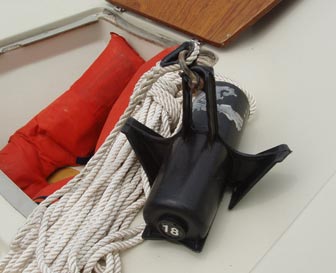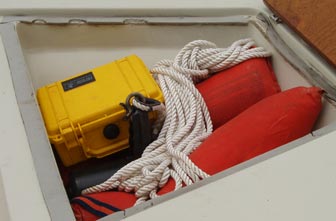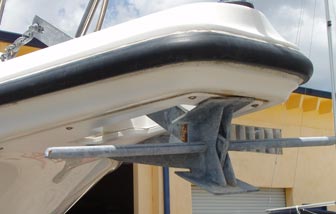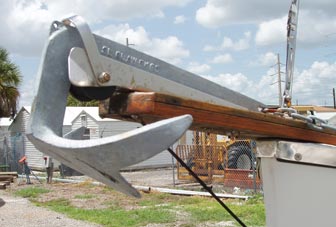When choosing an anchor for your boat, there are many factors you should consider. It may well be that you need more than one type of anchor to be properly prepared for all the types of situations you may encounter. The size (weight) and type of anchor you choose will be dictated by four main factors: the type and size of boat you wish to anchor, the nature of the bottom where you intend to anchor, the likely wind and wave conditions in which you will anchor, and the available anchor storage or anchor handling equipment on your boat.
On larger boats, you might want a small "lunch hook" anchor, to be used for short stays in good conditions, and a larger main anchor for more challenging conditions. Many cruisers carry more than one main anchor, plus a much larger storm anchor for use when it is necessary to ride out a storm at anchor.
There are anchor sizing guides provided by every manufacturer, but a simple rule applies for small boats that only carry one anchor: carry the largest anchor you can fit in your anchor locker or otherwise store safely and out of the way.
Types of anchors
|
|
There are many more types of anchors, but the list above encompasses the most common anchors and anchor styles.

 This plastic-coated crabclaw anchor fits nicely in the bow locker in my Boston Whaler, and it won't damage the gelcoat.
This plastic-coated crabclaw anchor fits nicely in the bow locker in my Boston Whaler, and it won't damage the gelcoat.
A Danforth anchor works well with this pulpit configuration.

A roller on the bow pulpit makes this Bruce anchor easier to deploy.
Anchors for Small Boats
Danforth style anchors are a popular choice for small boats because they lay relatively flat and will store more easily. On my 15' Boston Whaler, I have a Crabclaw Marine 18 lb anchor (see photo at left). The weight is excessive compared to the Danforth I previously used, but it fits nicely in the bow locker along with my boat tool kit and a life jacket. The plastic won't mar the gelcoat finish as metal anchors will, and the shape may be unconventional, but it has performed well.
Anchors for Mid-Size Boats
For mid sized boats of around 20 to 30 feet in length, choosing an anchor type and size gets a bit more complicated. Some boats have a bow pulpit with an anchor roller, while others have a forward locker for storing the anchor when not in use. Some pulpits are made to work well with one type of anchor, and won't perform well at all with another type. Before you begin evaluating anchor types and sizes, figure out which ones will work easily on your boat.
If you go with the Danforth or Northhill style anchors, use about 1/2 pound of anchor per foot of boat length. For CQR Plow type anchors, Bruce or claw anchors, or Navy style anchors, go a little heavier. Different rules apply to aluminum alloy anchors such as the Fortress, Guardian, and Bulldog. Because the material is lighter, you don't need as much weight, but you still need about the same size anchor.
It is the shape of the anchor, not the weight, that really holds the boat. A ten pound round steel ball won't do much to hold a 20 foot boat, but ten pounds of steel in the shape of an anchor can hold it through some pretty strong winds. If you can make the same shape and strength out of aluminum alloy and use only 6 pounds of material, it will still work the same once it is set.
The only problem I have seen with the lightweight aluminum anchors is that they sometimes tend to skip over sea grass without digging in, but I have seen steel anchors do the same thing. In both cases, the solution lies in using a proper amount of chain and nylon rode, and using correct anchoring technique to allow the anchor to catch and set.
Anchors for Larger Cruising Boats
For larger cruising boats, from about 30 to 50 feet, heavier bottom tackle is required. For Danforth and Northhill style anchors, use a ratio of one pound of anchor per foot of boat length. It is a good idea to use a heavier CQR plow or Bruce claw type anchor. The amount of chain should also be increased on larger heavier boats, especially those with lots of windage such as pilothouse cruisers or multihull vessels. One foot of heavy chain per foot of boat length is a good ratio.
Anchor Chain
Most people recommend using at least 6 or 8 feet of chain with small boat anchors, to help weigh down the anchor line and let the anchor dig into the bottom better. I don't carry chain in my Whaler, and I compensate for the lack of chain by always using a lot of scope when anchoring the boat in strong winds. My experience with short lengths of chain is that they are noisy, scaring away fish, they tend to scratch the gelcoat on your boat, and when you anchor in a very strong wind or current, they are pulled completely tight. They are not heavy or long enough to create a significant catenary curve in the anchor rode, so they don't help the angle at which the anchor is being pulled at all. A short chain on a small boat anchor is really only useful to help when initially setting the anchor, and as protection from chafing against rocks and things on the bottom. I don't anchor where there are rocks, so I omit the chain, but it may not be a good idea to follow my example on that one.
Although some of us get by without using chain on small boat anchors, on mid-sized boats and larger, anchor chain is an essential part of your anchoring setup. My advice is to use the longest, heaviest chain you can comfortably handle and store on your boat. A rule of thumb would be a minimum of 1/2 foot of chain per foot of boat length, but more chain will allow you to use a shorter overall scope and will help the anchor to dig in and set more easily. I use an average scope of 5 to 1, but increase or decrease that ratio depending on conditions. Bruce or claw type anchors are designed to use a shorter scope, but including some chain in the anchoring system is still important.
Connecting the Anchor Rode to the Anchor Chain
To connect nylon anchor rode to the anchor chain, most people put an eye splice around a thimble in the rope, then use a shackle to attach it to the chain. That system works well if the shackle is tightened with pliers and then wired with Monel seizing wire.
Another method is to use a rope-to-chain splice, a simple method of weaving a three strand or 8 strand anchor warp into the end of the chain. Here is a good step by step instruction on the rope to chain splice. The usually useful Grog's knots website describes a different rope to chain splice, which is essentially just an eye splice around the last link of the chain. That doesn't seem like a very good idea to me. Grog does mention one weakness of the rope to chain splice, especially for salt water boaters: the rope holds salt, and if it is woven into the first few links of chain, those links will be more prone to rust. As long as it is rinsed and monitored for rust, a warp to chain splice works very well, and eliminates the problem of thimbles and shackles snagging in bow anchor rollers and interrupting the use of a windlass.
Anchors and Bottom Type
The ratios I have mentioned for sizing anchors are just guidelines, and individual needs will vary quite a bit. All anchors will set and perform reasonably well in deep sand, but the type of holding ground that is prevalent in the places where you intend to anchor will affect which anchor is best for your boat.
Some anchors will drag across a hard mud bottom, but dig in readily in sea grass. In very soft mud, some anchors will pull right through the mud, making a nice trench but doing little to stop the boat. Fortress anchors have an adjustable fluke angle to compensate for this effect, presenting more blade surface to the mud. Rocky bottom is fairly unpredictable for any anchor, except that it is the most likely type of bottom to bend or break your anchor. Many commercial vessels that have to anchor in rocky areas use a grapnel hook style of anchor. When anchoring in rocks, it is a good idea to rig a trip line to the crown of your anchor to pull it out of trouble backwards.
We all want an anchor that will set quickly, will hold on a relatively short scope, and will be easy to handle and store. While those are all important considerations, remember that there may come a time when your anchor is the only thing to keep your boat from being smashed on rocks. It happened to me just outside Little Harbor, Abaco, and having a heavy anchor with lots of chain ready to deploy instantly really paid off.
More on Anchoring and Docking:
Leave a Reply
You must be logged in to post a comment.